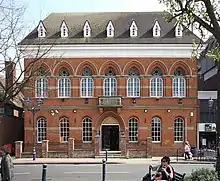Old Council House, Solihull
The Old Council House is a former municipal building in Poplar Road, Solihull, West Midlands, England. The town hall, which was the meeting place of Solihull Borough Council, is now a public house.
| Old Council House, Solihull | |
|---|---|
 Old Council House, Solihull | |
| Location | Poplar Road, Solihull |
| Coordinates | 52.4146°N 1.7784°W |
| Built | 1876 |
| Architect | J. A. Chatwin |
| Architectural style(s) | Italianate style |
 Shown in West Midlands | |
History
The first town hall in Solihull was on The Square on a site which had previously been part of St Alphege's Churchyard and was completed in 1848.[1][lower-alpha 1] In the early 1870s a small group of local businessmen formed a private company to erect and operate a more substantial public hall: the site they selected was on the east side of what was then a connecting road between Warwick Road and the High Street.[3][4]
The new building was designed by the Birmingham architect, J. A. Chatwin, in the Italianate style, built in red brick with stone dressings by a local builder, a Mr Deebank, and completed in 1876.[3] The design involved a symmetrical main frontage with seven bays facing onto Poplar Road; the central bay featured an arched doorway on the ground floor with a stone balcony above; there were seven gothic windows which were decorated with bar tracery with cusped circles (with bars radiating from the centre),[lower-alpha 2] flanked by Corinthian order colonettes, forming an arcade on the first floor and there were seven narrow dormer windows at attic level. Internally, the principal rooms were a courthouse on the ground floor and an assembly room on the first floor.[3]
After an increase in the population, largely associated with the town's increasing importance as a residential area for the people working in Birmingham, the area became an urban district in 1932.[6] There was a significant increase in the amount of casework in the courts in the 1930s, which led to the magistrates moving to a dedicated courthouse facility at Warwick Road in 1935.[1] This in turn allowed the new urban district council to convert the old courtroom into a council chamber and to adopt the building in Poplar Road as its council house.[1] After announcing the town's advancement to the status of a municipal borough, Princess Margaret waved to the crowds from the balcony of the council house and then signed the visitors' book on 11 March 1954.[7]
The building continued to serve as the council house for the borough until a purpose-built modern civic centre was completed in Manor Square in 1967.[1][8] The old council house was subsequently used as a public venue for concerts and other performances until it was converted by Wetherspoons into a public house known as the "Assembly Rooms" in 2008.[9] After being sold to the Stonegate Pub Company in 2016, it was rebranded as Yates Solihull.[10][11]
Notes
- The aging first town hall was demolished in 1879.[2]
- The style of tracery is derived from that employed at Reims Cathedral.[5]
References
- "Solihull Magistrates' Courts". Solihull Life. Retrieved 30 January 2021.
- Woodall, Joy (19 March 2018). "Rev. Charles Evans, Rector of Solihull". Solihull Local History Circle. Retrieved 30 January 2021.
- New Public Hall. 6. British Architect. 1 July 1876. p. 269.
- "Ordnance Survey Map". 1888. Retrieved 30 January 2021.
- Tracery at the Encyclopædia Britannica
- "Solihull CB/UD/MB". Vision of Britain. Retrieved 30 January 2021.
- "Local History - Charter Day". Solihull Metropolitan Borough Council. Archived from the original on 22 February 2013. Retrieved 6 March 2013.
- "Remember when Solihull looked like this? Archive pictures show town centre in the days before Touchwood". Birmingham Mail. 1 April 2018. Retrieved 30 January 2021.
- "Assembly Rooms, Poplar Street, Solihull". Birmingham Mail. 12 November 2008. Retrieved 30 January 2021.
- "Yates". What Pub. Retrieved 30 January 2021.
- "Solihull Town Centre Heritage Trail" (PDF). Solihull Metropolitan Borough Council. p. 3. Retrieved 30 January 2021.